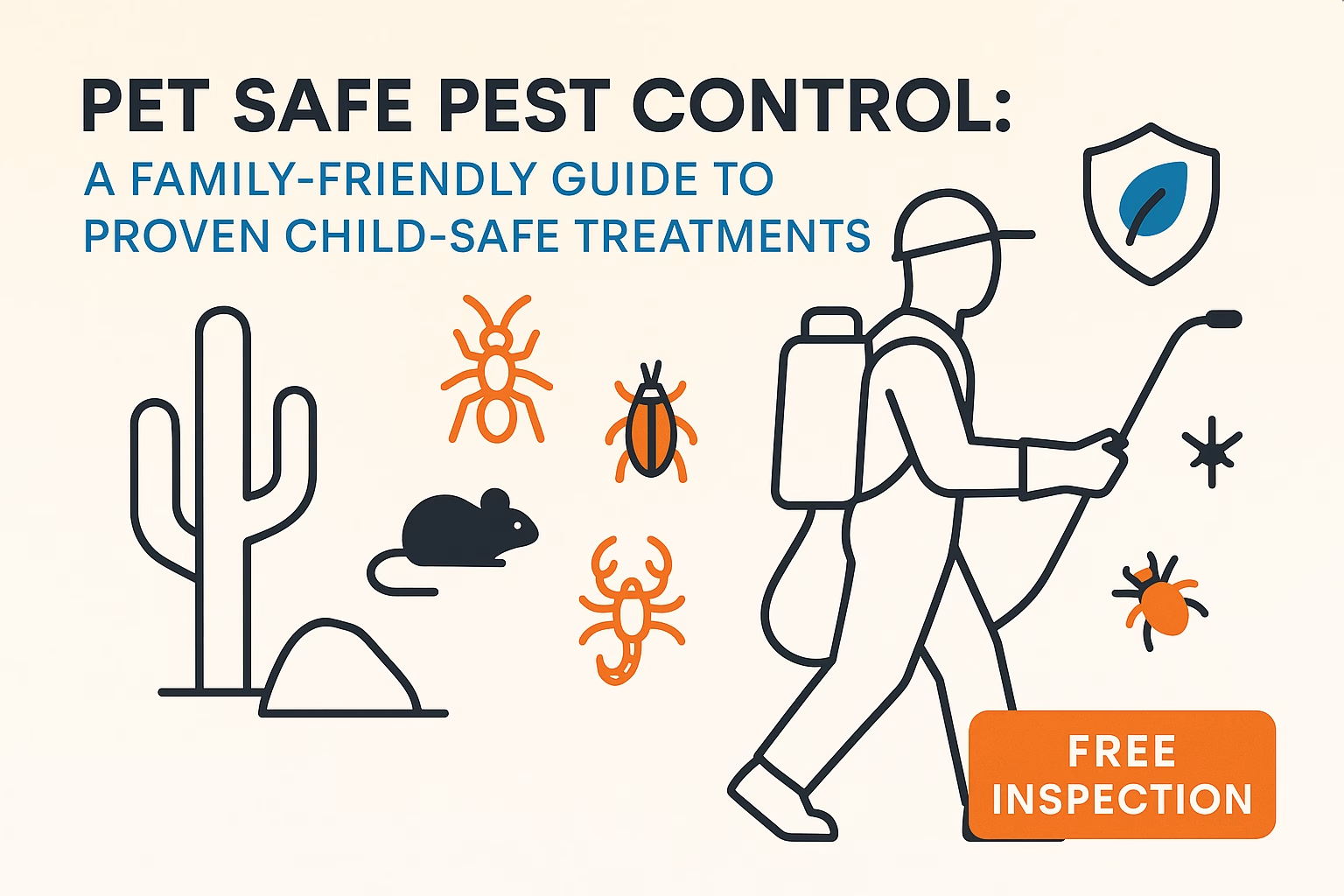Introduction: Are Your Pest Control Treatments Safe for Kids and Pets? Your Guide to Pet Safe Pest Control
You shouldn’t have to choose between a pest-free home and your family’s safety. Many treatments work—but not all are designed with pets, kids, and sensitive spaces in mind. The good news: with pet safe pest control and child safe pest control best practices, you can eliminate pests using family-friendly treatments that prioritize health, compliance, and long-term results.
This guide explains what “pet safe” really means, how pros minimize exposure without sacrificing effectiveness, what to look for on product labels, and how to keep every room—from nurseries to patios—protected and safe.
What Pet Safe Pest Control Really Means (and What It Doesn’t)
Defining pet safe pest control versus “natural” or “chemical-free” claims
Pet safe pest control doesn’t mean “no pesticides ever.” It means using an approach that reduces risk through strategy, precision, and product selection. The backbone is Integrated Pest Management (IPM), which emphasizes prevention and targeted treatments over broad, routine spraying.
- IPM fundamentals: exclusion, sanitation, habitat modification, monitoring, and only then, targeted treatments if needed.
- Targeted applications: crack-and-crevice work, baits in tamper-resistant stations, and dusts placed in inaccessible voids—methods designed to avoid pets’ paws and kids’ hands.
- Reduced-risk products: options with lower toxicity profiles or target-specific modes of action that are effective when used exactly as directed.
Be cautious with labels like “natural” or “chemical-free.” Natural doesn’t automatically equal safer. Potent botanicals (like clove, peppermint, or citrus oils) can irritate skin, sensitize airways, or be toxic to cats, birds, or fish if misused. Safety is determined by the product label, dosage, placement, and exposure—not by marketing terms.
Learn more about safer practices and IPM basics from the EPA: https://www.epa.gov/safepestcontrol
Child safe pest control: Similarities and key differences for kids’ environments
Kids—especially crawling infants and toddlers—explore with their hands and mouths. Child safe pest control mirrors pet-safe methods but adds safeguards for toys, soft surfaces, and high-contact areas.
- Nurseries and playrooms: prioritize enclosed baits and placements out of reach; avoid broadcast sprays on floors or play mats.
- Items kids mouth: pacifiers, bottles, stuffed toys, and teething rings should be removed or covered before service and cleaned after if directed by the label.
- Crawling zones: use targeted placements along edges and voids rather than exposed surfaces where hands and knees travel.
How Pros Deliver Family-Friendly Treatments Without Compromising Results
IPM workflow that reduces exposure
Reputable providers start with a process that minimizes product use:
- Inspection: locate pest sources, entry points, moisture, and conducive conditions.
- Identification: confirm species to choose the least-risk, most effective tactic.
- Exclusion: seal gaps, repair screens, and install door sweeps to block entry.
- Sanitation: reduce food, water, and clutter to take away pest resources.
- Monitoring: placement of sticky traps or stations to track activity before and after treatment.
- Threshold-based decisions: only treat when activity or damage exceeds action thresholds, minimizing broad applications.
Application methods that support pet safe pest control
When treatments are needed, pros focus on precision:
- Crack-and-crevice: apply into gaps, seams, and harborages rather than exposed surfaces.
- Baiting: use enclosed stations or gel baits in protected placements, keeping them inaccessible.
- Dusts in voids: apply into wall voids or under appliances where kids and pets can’t reach.
- Outdoor perimeter: treat exterior entry points to reduce the need for interior sprays.
 Online Only Pricing!
Online Only Pricing!
Tucson Pest Control—Fast, Local, Guaranteed
Book in minutes. Lock in our online-only rate and get priority scheduling.
- Stops ants, spiders, mice & pack rats
- No long-term contracts
- Family & pet-friendly options
- Money-back guarantee
Online takes ~60 seconds.
No gimmicks—just your price & schedule.
Prefer to talk? We can't guarantee our online prices over the phone.
We're happy to talk! Call us at (520) 476-0879
Product choices for family-friendly treatments
Product selection matters as much as placement:
- Baits: highly targeted, low-volume formulations that stay put (great for ants, roaches, rodents when used in tamper-resistant stations).
- Insect Growth Regulators (IGRs): disrupt pest life cycles (fleas, roaches) without relying solely on adulticides.
- Targeted aerosols and foams: used sparingly into harborages, not broadcasted.
- Reduced-risk formulations: sometimes botanical actives or modern chemistries with favorable profiles. They make sense when supported by label directions and the pest’s biology—but they’re not always the best choice for every situation.
Remember: even reduced-risk or botanical products require careful placement and label adherence.
Safety protocols: Re-entry, ventilation, and preparation
- Re-entry: follow the label—commonly, keep kids and pets out until surfaces are dry or for the specified time period.
- Ventilation: open windows/doors or run ventilation if the label suggests; avoid enclosed spaces with sensitive species present.
- Pre-service prep: cover aquariums, remove pet bowls and toys, secure enclosures, and clear floors and countertops in target areas.
- Post-service: return items after re-entry times; wipe food-contact surfaces if directed by the label.
How to Read Labels, Signal Words, and Certifications
Decoding labels to verify child safe pest control claims
Labels are the law—and your best safety guide. Before using or allowing any product inside your home, check:
- Signal words: CAUTION (lowest of the three), WARNING, or DANGER (highest) indicate relative acute toxicity.
- PPE requirements: proper protective equipment for the applicator helps ensure correct use.
- Target sites: look for “indoor,” “residential,” and “food areas” directives; products must be explicitly approved for the areas you plan to treat.
- Directions and restrictions: mixing rates, application methods, re-entry intervals, and ventilation instructions.
- First aid: keep the label accessible during and after application.
Helpful reference: UC IPM—Pesticides: Safe and Effective Use in the Home and Landscape: https://ipm.ucanr.edu/PMG/PESTNOTES/pn74126.html
Certifications and evaluations that support pet safe pest control
- EPA reduced-risk: some active ingredients carry reduced-risk status based on their toxicity and environmental profile for certain uses.
- Licensing: ensure your provider holds current state licenses for structural pest control.
- Third-party training and continuing education: look for providers who invest in IPM training, safety refreshers, and specialty certifications.
Room-by-Room and Yard Safety Guide for Family-Friendly Treatments
Kitchens, nurseries, and play areas
- Prep: move or cover toys, bottles, pet bowls, and small appliances; store food and utensils.
- Treatment preference: prioritize enclosed baits, gel placements in cracks, and void treatments versus open sprays.
- Aftercare: if the label indicates, wipe food-contact surfaces; keep baits in place undisturbed and out of reach; re-check for activity with sticky monitors.
Bedrooms, carpets, and soft goods
For fleas, bed bugs, and dust mites, take a control-first approach that reduces chemical reliance:
- Launder bedding and washable soft goods on high heat; dry thoroughly.
- Vacuum carpets, baseboards, and mattress seams; dispose of bags or clean canisters promptly.
- Encasements for mattresses and box springs in bed bug cases limit harborage and make inspections easier.
- Targeted treatments (IGRs, crack-and-crevice, or heat/steam where appropriate) minimize disruption and exposure.
Aquariums, birds, and small mammals
- Cover tanks tightly and turn off air pumps to prevent aerosol draw; relocate sensitive species if the label or pro recommends.
- Avoid pyrethrin/pyrethroid drift near fish and birds; these species are particularly sensitive.
- Ventilate well after treatments and wait for re-entry per the label before returning pets.
 Online Only Pricing!
Online Only Pricing!
Tucson Pest Control—Fast, Local, Guaranteed
Book in minutes. Lock in our online-only rate and get priority scheduling.
- Stops ants, spiders, mice & pack rats
- No long-term contracts
- Family & pet-friendly options
- Money-back guarantee
Online takes ~60 seconds.
No gimmicks—just your price & schedule.
Prefer to talk? We can't guarantee our online prices over the phone.
We're happy to talk! Call us at (520) 476-0879
Lawns, patios, and pollinator-friendly practices
- Timing: apply outdoors when pollinators are least active (early morning or late evening) and avoid blooming plants when possible.
- Spot treat nests and harborage areas rather than broadcast across the entire yard.
- After lawn treatments: keep pets and kids off turf until dry or as the label directs; wipe paws if they contact treated areas sooner than planned.
- Encourage beneficials: maintain diverse plantings and reduce unnecessary treatments to support natural predators.
DIY vs Professional: Choosing the Safest Path
Low-risk, DIY-first steps for pet safe pest control
- Seal entry points: caulk gaps, repair weatherstripping, and add door sweeps.
- Reduce moisture: fix leaks, improve ventilation, and use dehumidifiers in damp areas.
- Sanitation: store food in sealed containers, clean crumbs/grease, and remove clutter.
- Monitoring: place sticky traps to identify hot spots.
- Enclosed baits: in tamper-resistant stations and out of reach—never loose rodenticide or open bait where pets or kids can access.
When to call for family-friendly treatments
- High-risk pests: wasps/hornets, venomous spiders, rodents (risk of disease and secondary poisoning), termites, and bed bugs.
- Large or persistent infestations: when monitoring shows increasing trends or DIY tactics stall.
- Structural exclusion: chimney caps, crawlspace repairs, or heavy-duty rodent-proofing.
- Advanced, targeted products: when specific chemistries, equipment, or application techniques are required.
Questions to Ask Your Provider About Pet Safe Pest Control
Before scheduling service
- What IPM steps will you use before applying products?
- Which target-specific, low-odor, or reduced-risk options do you recommend for my home?
- How will you protect kids, pets, aquariums, and sensitive areas during treatment?
During and after treatment
- What are the re-entry times for kids and pets?
- What prep and post-care steps should we follow?
- How do you monitor results and adjust for child safe pest control if activity continues?
Myths and Mistakes That Can Put Families at Risk
“If it’s natural, it’s safe for kids and pets”
Not necessarily. Concentrated essential oils and botanicals can irritate skin and airways and may be toxic to cats, birds, or fish. Always follow the label, avoid over-application, and keep products out of reach.
“More product = better results”
Over-application increases exposure and resistance risk without better outcomes. IPM and precise placements beat heavy, repeated spraying every time.
“No odor means no risk”
Odor is not a safety indicator. Some low-odor products carry significant risks if misused. Always rely on the label, not your nose.
What To Do If Exposure Happens (Pets or Kids)
Immediate steps and who to call
- Get to fresh air, remove from treated areas, and ventilate.
- Check the product label and follow first aid instructions exactly.
- For pets: contact your veterinarian or ASPCA Animal Poison Control: https://www.aspca.org/pet-care/animal-poison-control.
- For children: call your local poison control center (in the U.S., 1-800-222-1222) and have the product label in hand.
Proof of Performance: Measuring Safe, Long-Term Results
- Follow-up inspections: verify reductions in activity with monitors and visual checks.
- Non-chemical controls: traps, exclusion, moisture management, and sanitation to reduce reliance on products.
- Trend-based adjustments: tailor placements and strategies based on data, seasons, and structural changes.
- Preventive maintenance: seal new gaps, keep vegetation trimmed, and store food properly to minimize future treatments.
Conclusion: Confidently Choose Pet Safe Pest Control for a Healthier Home
Effective pest management and safety can go hand in hand. By prioritizing IPM-first strategies, using targeted applications, following product labels, and insisting on provider transparency, you can achieve child safe pest control and family-friendly treatments without sacrificing results. Ready to protect your home the right way? Schedule an inspection with a licensed professional who prioritizes pet safe pest control, and ask about their IPM plan, re-entry times, and monitoring strategy.





